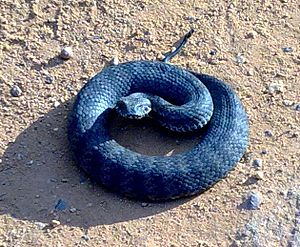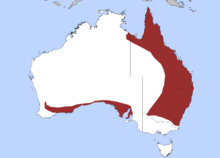Death otter
| Death otter | ||||||||||||
|---|---|---|---|---|---|---|---|---|---|---|---|---|

Death adder ( Acanthophis antarcticus ) |
||||||||||||
| Systematics | ||||||||||||
|
||||||||||||
| Scientific name | ||||||||||||
| Acanthophis antarcticus | ||||||||||||
| ( Shaw & Nodder , 1802) |
The death adder ( Acanthophis antarcticus , syn .: Acanthophis schistos ) is a species of snake from the family of poisonous snakes (Elapidae), which occurs in large parts of southern, eastern and northern Australia .
features
Death otters usually reach a length of 50 to 60 centimeters, a maximum of about one meter. The trunk is flattened laterally, strong and plump like a viper . The triangular head is flat, very broad and clearly set off from the neck. Conspicuously angled, erect over- eye shields stand above the small eyes with vertical elliptical pupils . The fangs are unusual move for a poisonous snake and long, they measure six or more millimeters. When bitten, they can penetrate deep into the tissue vertically. The scales of the back, arranged in 21 to 23 oblique rows, are smooth or slightly keeled. The upper side of the body is usually light to dark gray or rust brown with more or less distinct, dark transverse bands and adapted to the environment. The belly is lighter and often has numerous dark spots. It has 110 to 135 abdominal shields , an undivided anal shield and 25 to 60 subcaudal shields . The tail is short and thin, white or cream colored and ends in an erect, thorn-like appendage.
Way of life
Dead otters usually spend the day buried in sandy ground or hidden between stones or vegetation. At night they hunt small mammals, birds, reptiles and amphibians, whereby prey animals are sometimes attracted by movements of the tip of the tail. The mating takes place in the Australian spring. Most of the 10 to 24 boys are born alive .
Poison
The poison of the death adder is highly neurotoxic and causes muscle rigidity similar to the effect of curare . In addition, there is a weak tissue-decomposing and anticoagulant effect. Death otters are relatively sluggish and usually do not flee even after biting. While it is frequently reported in the literature that up to 50% of the death adder bites in humans lead to death from respiratory paralysis if untreated, scientific studies indicate a rate of only around 15%. There are effective antidotes that quickly reverse the paralysis caused by the poison.
Trivia
The females of the shield bird of paradise cover the edge of their nests with the shed skin of this snake. The behavior probably serves to deter predators.
swell
- L. Trutnau: Venomous snakes . Verlag Eugen Ulmer, Stuttgart 1998, ISBN 3-8001-7371-9 , p. 47-48 .
Web links
Individual evidence
- ↑ L. Trutnau: poisonous snakes . Verlag Eugen Ulmer, Stuttgart 1998, ISBN 3-8001-7371-9 , p. 47-48 .
- ↑ D. Chiszar, D. Boyer, R. Lee, JB Murphy, CW Radcliffe: Caudal luring in the southern death adder, Acanthophis antarcticus . In: Journal of Herpetology . tape 24 , no. 3 , 1990, p. 253-260 (English).
- ^ CH Campbell: The death adder (Acanthophis antarcticus): the effect of the bite and its treatment . In: The Medical Journal of Australia . tape 2 , no. 20 , 1966, pp. 922–925 (English, kingsnake.com [PDF]).
- ^ PJ Higgins, JM Peter and SJ Cowling: Handbook of Australian, New Zealand & Antarctic Birds. Volume 7: Boatbill to Starlings. Part A: Boatbill to Larks. Oxford University Press, Melbourne 2006, ISBN 978-0-195-55884-5 , p. 638.
